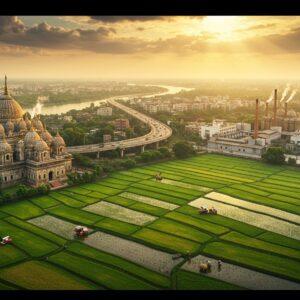
The Kaveri River, flowing over 800 kilometers from Karnataka to Tamil Nadu, is a vital resource in southern India. It plays a crucial role in agriculture, supports diverse wildlife, and holds immense cultural and historical significance. As of 2025, understanding the Kaveri’s impact is essential for appreciating its ecological and economic value, especially given the challenges of reduced rainfall, land diversion, and climate change.
How the Kaveri River Supports Agriculture
The Kaveri River Basin, particularly the delta region, is renowned for its agricultural productivity. The river’s extensive irrigation networks are essential for cultivating various crops, including rice, a staple food in South India. Despite a 20% shrinkage of the delta due to land diversion and climate change, the Kaveri continues to be a crucial water source. Upstream dams, while providing water storage, also prevent silt from reaching the delta, affecting its fertility. Despite these challenges, the river remains vital for agricultural practices and food security in the region.
Sugarcane, a major cash crop, also thrives thanks to the Kaveri’s waters, boosting local economies. Other essential crops like pulses, cotton, and various horticultural products benefit from the river’s irrigation, contributing to the region’s agricultural diversity. Traditional farming techniques, deeply connected to the river’s natural cycles, are still practiced, reflecting the enduring bond between communities and the Kaveri. The river’s role in tackling water scarcity becomes increasingly important in the face of climate change.
Impact of the Kaveri River on Wildlife
Beyond agriculture, the Kaveri River is essential for supporting a rich biodiversity. The river’s ecosystem provides habitat for various wildlife species, including those facing endangerment. The forests and wetlands along the riverbanks are home to a diverse range of birds, contributing to the overall ecological balance. Aquatic life, particularly fish species like the Mahseer, rely on the river’s health. During dry periods, the Kaveri becomes a critical water source for animals in regions like Coorg and the Nilgiris, highlighting its importance for wildlife survival.
Protecting the Kaveri’s natural habitats is crucial for maintaining this biodiversity. However, pollution and habitat loss pose significant threats. Conservation efforts are underway to address these challenges and preserve the river’s ecological integrity. The cultural and religious significance of the Kaveri often incorporates elements of wildlife conservation, reflecting the deep connection between local communities and the natural world.
The Kaveri River’s Role in Supporting Coorg Wildlife
Coorg, a region known for its biodiversity, relies heavily on the Kaveri River. The river and its tributaries create a network of habitats that shelter various species, including the Asian elephant and the Malabar giant squirrel. The interplay between the river’s resources and Coorg’s unique climate fosters a diverse range of flora and fauna. The Kaveri plays a crucial role in maintaining the health of Coorg’s forests, which are essential for regional biodiversity. The river’s ecological services also help mitigate challenges such as land-use changes and human-wildlife conflicts.
The cultural importance of the Kaveri in Coorg is reflected in traditional practices that promote sustainable wildlife management. These practices highlight the deep connection between the local communities and the river’s ecosystem.
Crops Thriving Along the Kaveri River
The Kaveri River’s waters nourish a diverse agricultural landscape. Rice paddies are a prominent feature, with the river’s irrigation systems enabling high-yield rice farming, particularly in the delta regions. Sugarcane cultivation also benefits significantly from the reliable water supply, contributing to local industries.
Pulses, an important part of local diets, thrive with the Kaveri’s irrigation. Cotton farming, essential for the textile industry, also relies on the river’s waters. Horticultural crops, including a variety of fruits and vegetables, flourish due to the fertile soils and ample water provided by the Kaveri. Increasingly, the river is supporting the adoption of organic and sustainable farming practices.
Fish and Aquatic Life in the Kaveri
The Kaveri River supports a diverse array of fish species, crucial for local fisheries and overall biodiversity. The Mahseer fish, in particular, serves as both an ecological indicator and an economic asset. A healthy Kaveri ecosystem supports a wide range of aquatic life, including crustaceans and mollusks, contributing to the river’s ecological richness.
Fish breeding grounds along the river are essential for maintaining healthy fish populations. Traditional fishing practices reflect the cultural connection between local communities and the river’s aquatic resources. However, pollution and overfishing pose threats to fish populations, necessitating conservation programs. These initiatives aim to protect the Kaveri’s aquatic life, supporting both ecological balance and the livelihoods of communities that depend on the river.
Poojn.in: Supporting Kaveri River Rituals and Conservation
Recognizing the spiritual significance of the Kaveri River, Poojn.in offers a curated selection of products for traditional river worship and conservation efforts. We provide pure copper vessels, known for their sacred properties in water-related rituals, and eco-friendly puja items ideal for Kaveri-related offerings.
Our specialized Kaveri Puja Kit includes:
- Pure copper kalash for water offerings: Ideal for sacred rituals and maintaining water purity.
- Natural cotton wicks for aarti: Supporting traditional practices with eco-friendly materials.
- Organic kumkum and turmeric: Using natural ingredients for your rituals.
- Chemical-free incense sticks: Minimizing environmental impact while honoring traditions.
- Biodegradable flowers and garlands: Offering beautiful tributes that respect the environment.
These items are designed to support both traditional practices and environmental protection of the Kaveri River. Poojn.in is committed to providing high-quality products sourced from authentic manufacturers who follow traditional crafting methods. Visit our website to explore our complete range of river worship items and contribute to preserving the Kaveri’s sacred traditions while supporting sustainable practices.
[Note: All mentioned products are subject to availability. Please check our website for current stock and pricing.]
Conclusion: The Everlasting Bond with the Kaveri
The Kaveri River stands as a timeless symbol of life, resilience, and hope for the people of southern India. In 2025 and beyond, its role as a lifeline for both agriculture and wildlife remains crucial. The river’s waters nourish not only the land but also the cultural and spiritual traditions of the region. As we face increasing environmental challenges, the bond between the Kaveri and its people becomes even more significant, inspiring continued efforts towards sustainable practices and conservation. Protecting the Kaveri is not just about preserving a river; it is about safeguarding a legacy for generations to come.
FAQs: Kaveri River’s Impact in 2025
How is the Kaveri River a lifeline for Coorg wildlife?
The Kaveri River and its tributaries form a vital network of habitats in Coorg, providing water and sustenance for a wide range of wildlife, including elephants, tigers, and numerous bird species. This intricate ecosystem relies heavily on the river’s health.
What crops are grown along the Kaveri River?
The fertile lands along the Kaveri River support the cultivation of various crops, including rice, sugarcane, and coffee. The river’s irrigation is essential for the successful growth of these crops, contributing significantly to the region’s agricultural output.
Why is the Kaveri River important for agriculture?
The Kaveri River is a crucial source of irrigation water for agriculture in the region. It sustains the growth of essential crops and supports the livelihoods of countless farmers who depend on its waters. The river’s role in food security is paramount.
What types of fish are found in the Kaveri River?
The Kaveri River is home to a variety of fish species, including Mahseer, Catfish, and Carp. These fish play a vital role in local fishing communities and contribute to the river’s biodiversity. They are an essential part of the river’s ecosystem.
How does the Kaveri River impact wildlife in 2025?
In 2025, the Kaveri River continues to be a critical source of water and habitat for wildlife in the region. Ongoing conservation efforts aim to protect this delicate balance and ensure the river’s continued support for wildlife for future generations.
What challenges does the Kaveri River face?
The Kaveri River faces several challenges, including pollution from various sources, overuse of water for agricultural purposes, and the impacts of climate change. These issues threaten the river’s health and its ability to sustain both agriculture and wildlife.
How does the Kaveri River benefit local communities?
The Kaveri River is deeply intertwined with the lives of local communities. It provides essential resources like drinking water, supports agricultural activities and fishing, and plays a significant role in cultural and religious traditions. The river is integral to their daily lives and well-being.


